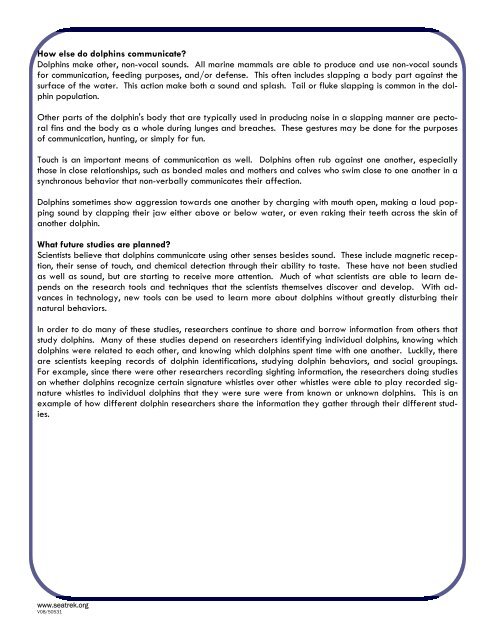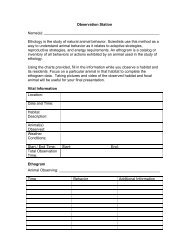LESSON 2 - SeaTrek Programs
LESSON 2 - SeaTrek Programs
LESSON 2 - SeaTrek Programs
Create successful ePaper yourself
Turn your PDF publications into a flip-book with our unique Google optimized e-Paper software.
How else do dolphins communicate?<br />
Dolphins make other, non-vocal sounds. All marine mammals are able to produce and use non-vocal sounds<br />
for communication, feeding purposes, and/or defense. This often includes slapping a body part against the<br />
surface of the water. This action make both a sound and splash. Tail or fluke slapping is common in the dolphin<br />
population.<br />
Other parts of the dolphin's body that are typically used in producing noise in a slapping manner are pectoral<br />
fins and the body as a whole during lunges and breaches. These gestures may be done for the purposes<br />
of communication, hunting, or simply for fun.<br />
Touch is an important means of communication as well. Dolphins often rub against one another, especially<br />
those in close relationships, such as bonded males and mothers and calves who swim close to one another in a<br />
synchronous behavior that non-verbally communicates their affection.<br />
Dolphins sometimes show aggression towards one another by charging with mouth open, making a loud popping<br />
sound by clapping their jaw either above or below water, or even raking their teeth across the skin of<br />
another dolphin.<br />
What future studies are planned?<br />
Scientists believe that dolphins communicate using other senses besides sound. These include magnetic reception,<br />
their sense of touch, and chemical detection through their ability to taste. These have not been studied<br />
as well as sound, but are starting to receive more attention. Much of what scientists are able to learn depends<br />
on the research tools and techniques that the scientists themselves discover and develop. With advances<br />
in technology, new tools can be used to learn more about dolphins without greatly disturbing their<br />
natural behaviors.<br />
In order to do many of these studies, researchers continue to share and borrow information from others that<br />
study dolphins. Many of these studies depend on researchers identifying individual dolphins, knowing which<br />
dolphins were related to each other, and knowing which dolphins spent time with one another. Luckily, there<br />
are scientists keeping records of dolphin identifications, studying dolphin behaviors, and social groupings.<br />
For example, since there were other researchers recording sighting information, the researchers doing studies<br />
on whether dolphins recognize certain signature whistles over other whistles were able to play recorded signature<br />
whistles to individual dolphins that they were sure were from known or unknown dolphins. This is an<br />
example of how different dolphin researchers share the information they gather through their different studies.<br />
www.seatrek.org<br />
V08/50531





